I love gardening, and one of the most rewarding aspects is creating a vibrant space that looks great all year.
It can be a challenge to maintain color through the changing seasons, but there are plenty of easy ways to keep your garden lively and inviting.
With a little planning and creativity, I can transform my garden into a colorful oasis, no matter the time of year.
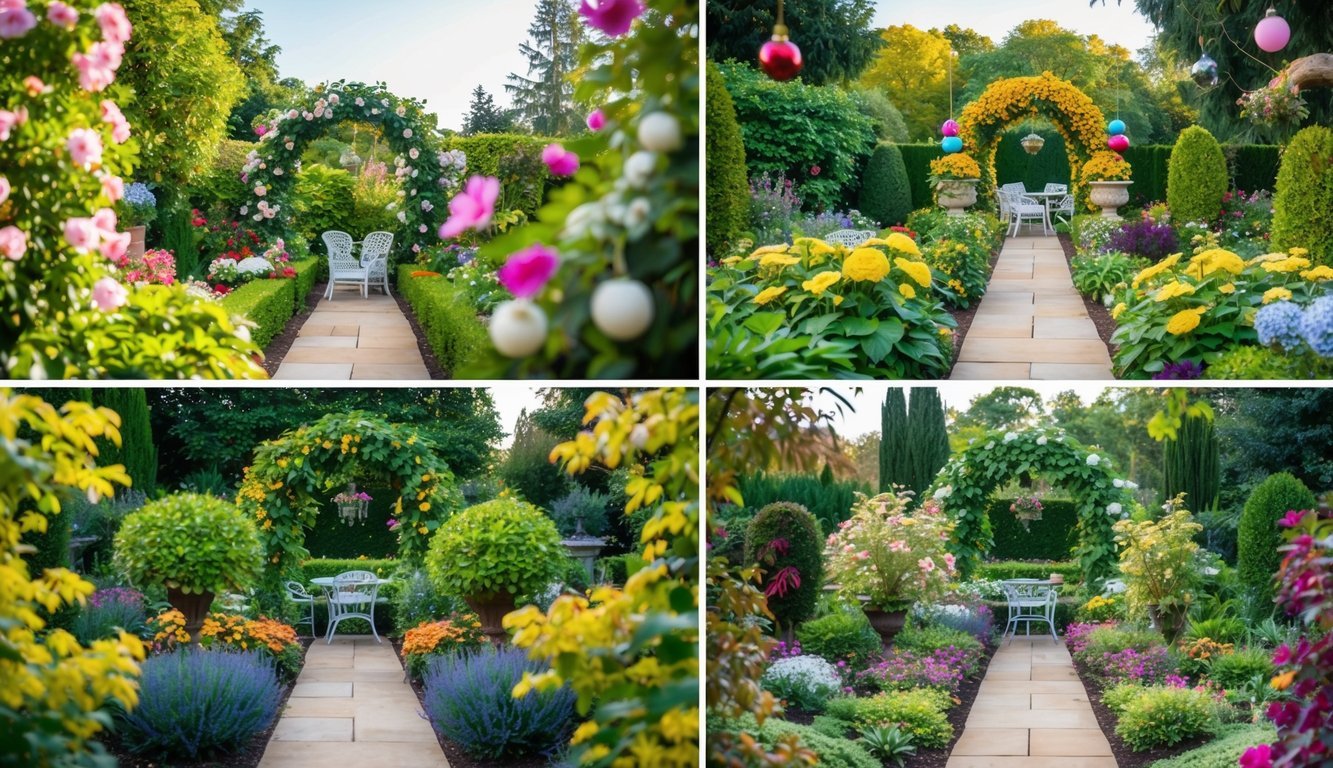
Adding color to my garden involves more than just a few flowers.
From selecting the right plants to incorporating different textures, there are simple strategies that can make a significant impact.
By exploring various options, I can ensure my garden remains visually appealing, whether it’s spring, summer, fall, or winter.
1) Plant Tulips for Spring Blooms
I love adding tulips to my garden for vibrant spring color.
These flowers come in so many hues, making it easy to find the perfect match for any garden scheme.
To get started, I always plant tulip bulbs in the fall.
This timing ensures they get the chilling period they need to bloom beautifully in spring.
In my area, I find it best to plant bulbs about 8 to 12 inches deep.
I like to mix colors for a cheerful look or stick with one shade for a striking display.
When I dig the planting holes, I add compost to give the bulbs a nutrient boost.
After placing them in the ground, I water gently to keep the soil moist.
For those in warmer climates, swapping in pre-chilled bulbs can help achieve those stunning blooms.
Watching the tulips pop up each spring never fails to brighten my garden.
2) Use Vibrant Marigolds
I love adding marigolds to my garden for a splash of color.
They come in shades of orange, yellow, and red, making them perfect for brightening up any space.
Growing marigolds is quite simple.
I usually start them from seed in early spring.
If you want quick results, you can even plant them directly in the ground after the last frost.
These flowers are pretty versatile too.
I like to use marigolds along borders, around shrubs, or even in containers.
They look great anywhere!
Not only are they visually appealing, but marigolds also attract pollinators like bees and butterflies.
Plus, they help deter some pests.
It’s nice knowing I’m adding beauty while keeping my garden healthy.
Whether I’m an experienced gardener or just starting out, marigolds are a solid choice for year-round color.
They’re easy to care for and bloom continuously, making every corner of my garden vibrant and lively.
3) Add Some Lavender for Summer Scents
I love adding lavender to my garden for its delightful fragrance and beautiful blooms.
It’s perfect for summer, bringing vibrant colors and an inviting scent to my space.
Planting lavender can create a stunning border along pathways or garden beds.
The deep purple flowers contrast nicely with green foliage.
I often use it to line a garden path, making strolls through my yard feel extra special.
Incorporating lavender into a sunny spot can attract beneficial pollinators like bees and butterflies.
Watching them flit around adds life to my garden.
I also enjoy cutting fresh lavender for indoor arrangements.
The scent brings a touch of summer inside my home.
Plus, it can be used in DIY projects, like making lavender-infused oils or sachets.
Overall, lavender is not just a beautiful plant; it’s also practical.
It thrives in well-drained soil and doesn’t need much water once established.
This makes it a low-maintenance addition to my garden.
4) Incorporate Heuchera Foliage
I love adding Heuchera to my garden for a pop of color.
Known as coral bells, these plants have stunning leaves in various hues, including deep black, vibrant green, and soft silver.
Planting Heuchera is simple.
I usually choose a spot with partial to full shade to protect the leaves from scorching.
They thrive in well-draining soil.
Spacing them 1 to 2 feet apart allows for good air circulation and helps prevent rot.
Watching the foliage change with the seasons is a bonus.
Their colors remain vivid even into fall, making them a fantastic addition for year-round interest.
I often use Heuchera in borders, rock gardens, or containers.
They look great on their own or mixed with other plants.
The small, bell-shaped flowers add a delicate touch, but it’s the leaves that really steal the show.
With so many varieties available, I can easily find the perfect Heuchera to complement my garden style.
Adding this plant can transform dull spaces into colorful retreats effortlessly.
5) Grow Autumn Crocus to Extend Color
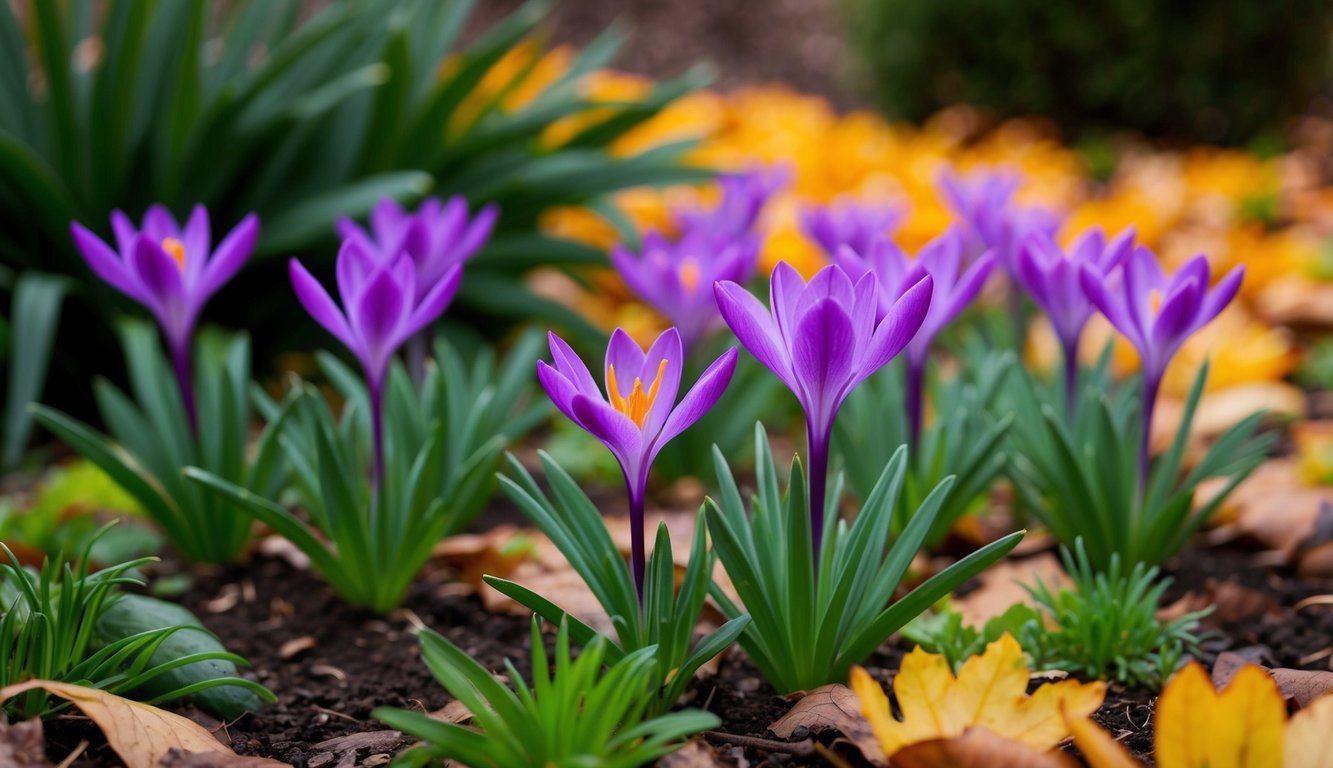
I love adding autumn crocus to my garden to enjoy vibrant colors late in the season.
These lovely blooms appear when most plants are fading, bringing purples, whites, and yellows to my landscape.
Autumn crocus, also known as Meadow Saffron, adds a unique touch as they bloom in the fall.
They thrive with minimal care, making them perfect for busy gardeners like me.
These bulbs can grow in various soil types and are hardy, which is a plus.
When I plant them, I ensure they have plenty of sunlight to really shine.
It’s essential to remember that while autumn crocus looks similar to edible saffron, they are toxic.
I always double-check before planting to keep things safe in my garden.
Adding these flowers not only boosts color but also extends the blooming season in my outdoor space.
I find their arrival refreshing, signaling the transition into fall while providing year-round interest.
6) Try Japanese Maples for Red Leaves
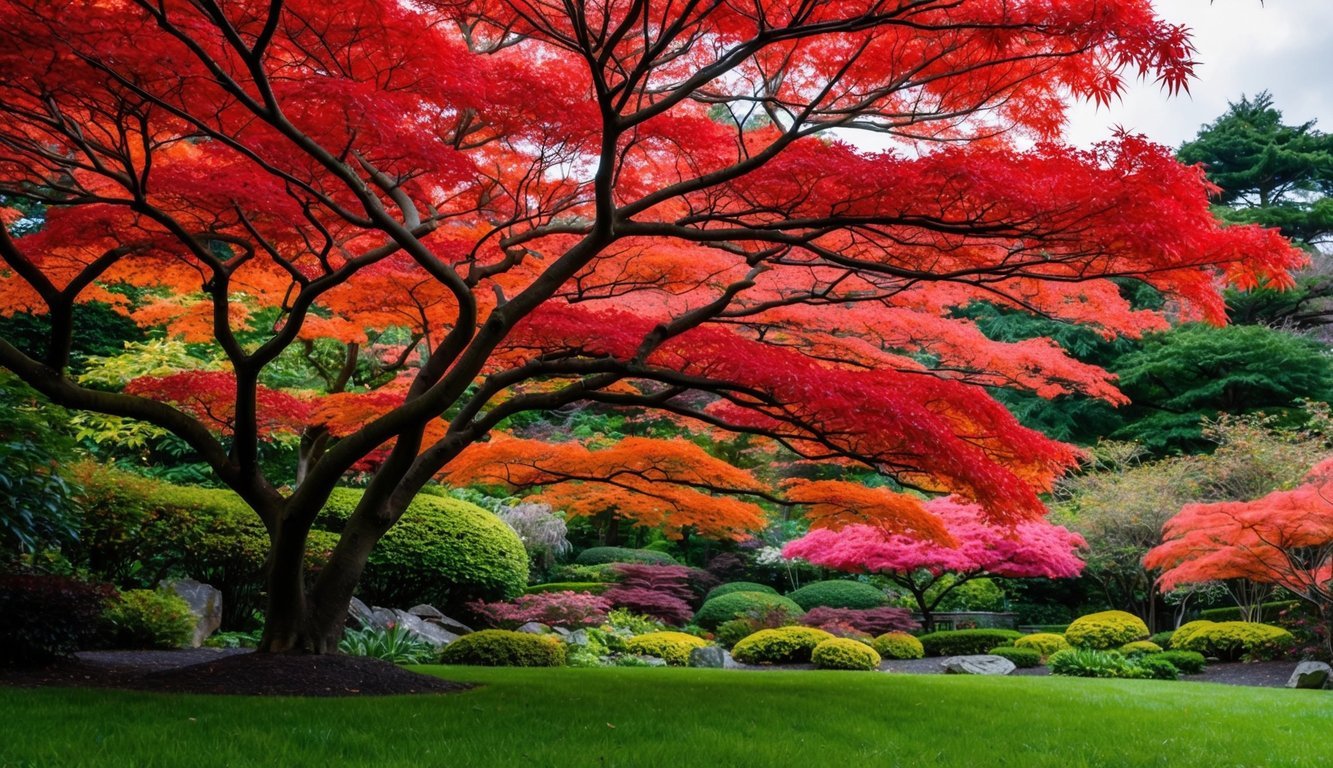
I truly appreciate how Japanese maples bring a burst of color to any garden.
Their striking red leaves can add a stunning focal point, especially in the fall.
One of my favorites is the ‘Osakazuki’ variety.
It showcases brilliant red leaves that seem to glow, especially when sunlight filters through them.
It’s a treat to watch the vibrant green leaves transform into crimson shades as the season changes.
Another great option is the Shantung maple, with its unique blend of red, orange, and yellow in the fall.
It’s a smaller tree, making it perfect for urban gardens.
These maples are hardy and can tolerate varying climates, which makes them versatile.
Whether I’m looking for color or an elegant shape, Japanese maples never disappoint.
They effortlessly enhance my garden’s beauty throughout the year.
7) Include Winterberry Shrubs
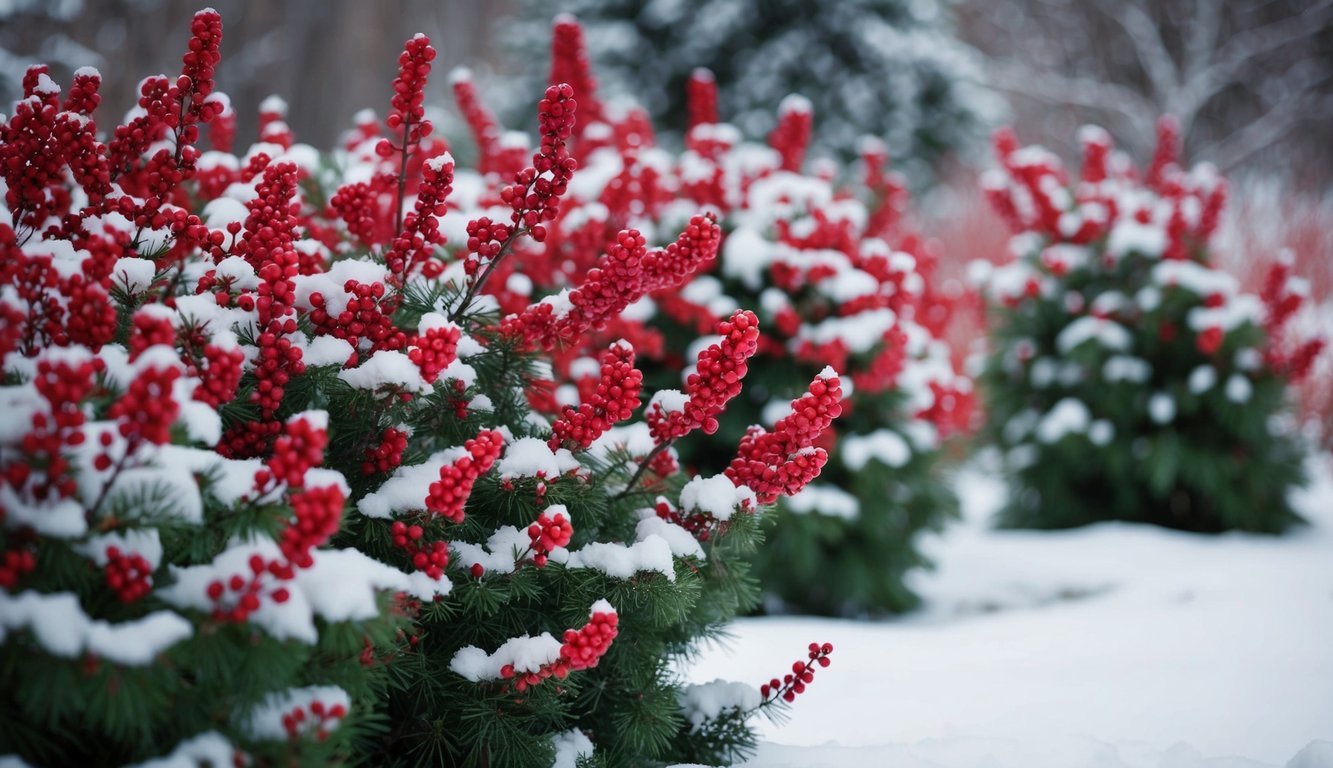
I love adding winterberry shrubs to my garden for a splash of color during the colder months.
These hardy plants produce bright red berries that look stunning against a winter backdrop.
Winterberries can reach heights of 6 to 10 feet.
They thrive in low-lying or damp spots, making them a versatile choice for many garden layouts.
In spring, they showcase small white flowers that transition into vibrant berries by summer.
The foliage turns yellow or orange in the fall, further enhancing their seasonal appeal.
These shrubs are not just pretty; they’re also native and support local wildlife.
Birds find winterberries particularly irresistible, so I often spot them flocking around my garden.
When planning my garden, I make sure to include a mix of winterberry varieties.
This ensures that I enjoy their beauty throughout the winter and into the next growing season.
8) Plant Pansies for Winter Appeal
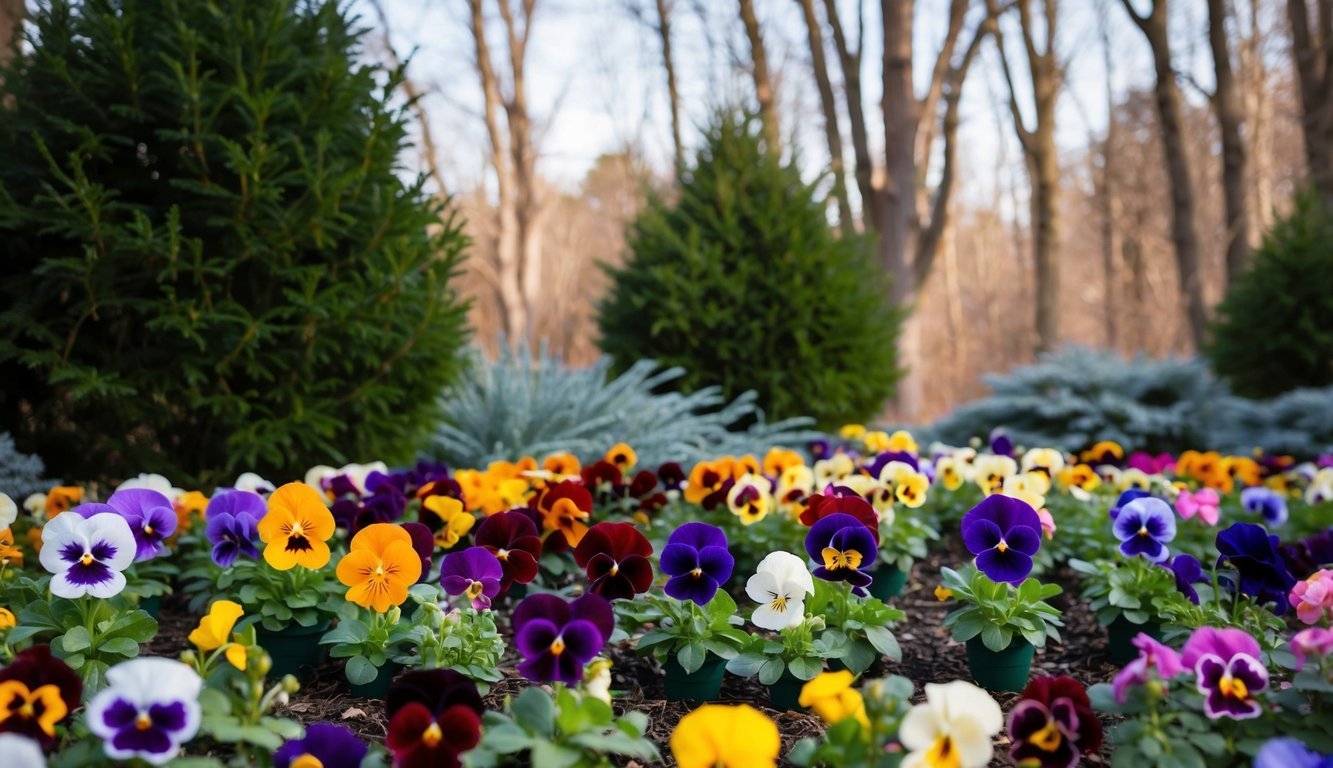
I love adding pansies to my garden during the colder months.
These hardy flowers bring bright colors when everything else looks bare.
I typically choose winter pansies because they thrive in cooler temperatures.
They can withstand frost, adding vibrant pops of color to my garden that really brighten the winter landscape.
When planting, spacing them 7 to 12 inches apart helps them grow well.
I make sure to plant them in early spring or late summer, depending on my local climate.
I find that they prefer well-drained soil to avoid root rot.
Watering them is important, but I keep an eye on moisture levels to ensure they don’t get too wet.
With just a little care, my winter pansies flourish and provide delightful blooms all season long.
They’re an effortless way to maintain color in my garden during the winter months.
9) Use Colorful Garden Art
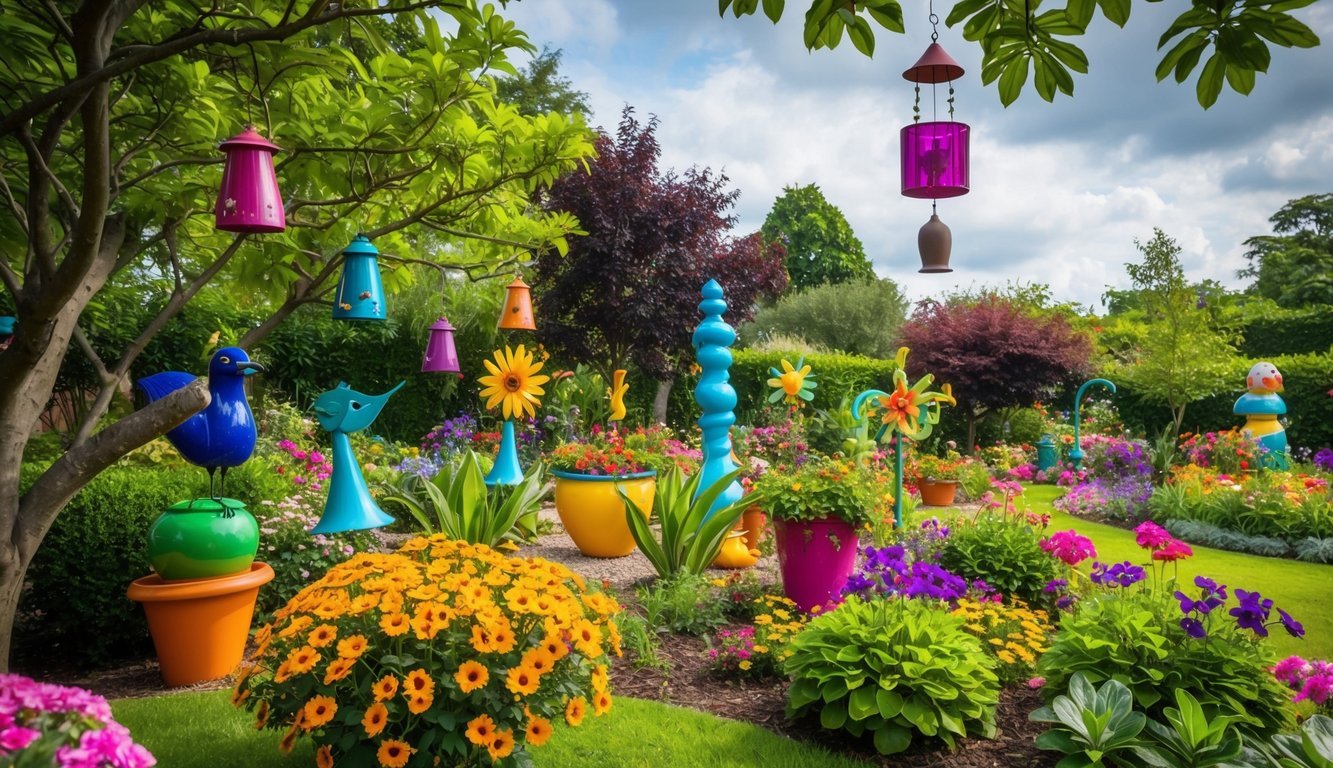
I love adding colorful garden art to my outdoor space.
It’s an easy way to infuse personality and vibrancy into the garden.
From sculptures to decorative stakes, there’s a wide range of options.
I often choose pieces that complement the plants around them, creating a harmonious look.
Brightly painted pots or whimsical wind chimes can bring life to any corner.
Each piece can reflect my style while enhancing the overall aesthetic.
I also enjoy incorporating seasonal art for a fresh touch throughout the year.
This keeps the garden feeling dynamic and inviting, no matter the season.
Plus, colorful art can serve as focal points, drawing the eye and creating interest.
It’s fun to mix and match different styles and colors to see what works best.
10) Incorporate Painted Rocks
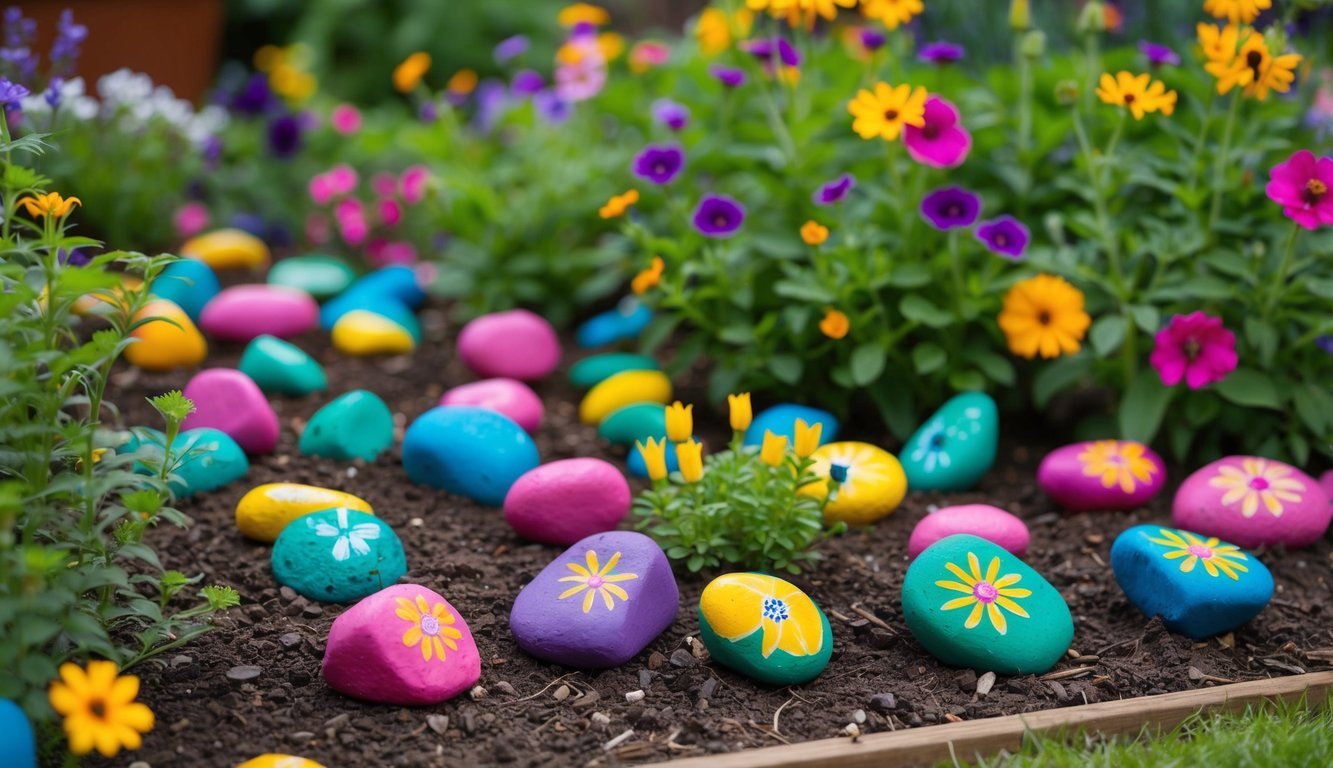
I love adding personality to my garden with painted rocks.
They are simple to make and can brighten up any corner.
I like to get creative with different colors and patterns.
Sometimes, I paint my house number or family names for a fun touch.
Placing these rocks along flower beds or around trees creates a playful atmosphere.
They can also serve as unique borders for pathways.
Experimenting with themes can be enjoyable too.
For example, seasonal designs can change throughout the year, keeping my garden looking fresh.
Using painted rocks is an easy and affordable way to bring color into my outdoor space.
Plus, it’s a great project to involve kids in, sparking their creativity as well.
Mixing painted rocks with natural elements enhances the garden’s beauty.
It’s a small detail that makes a big impact!
Understanding Plant Color Cycles
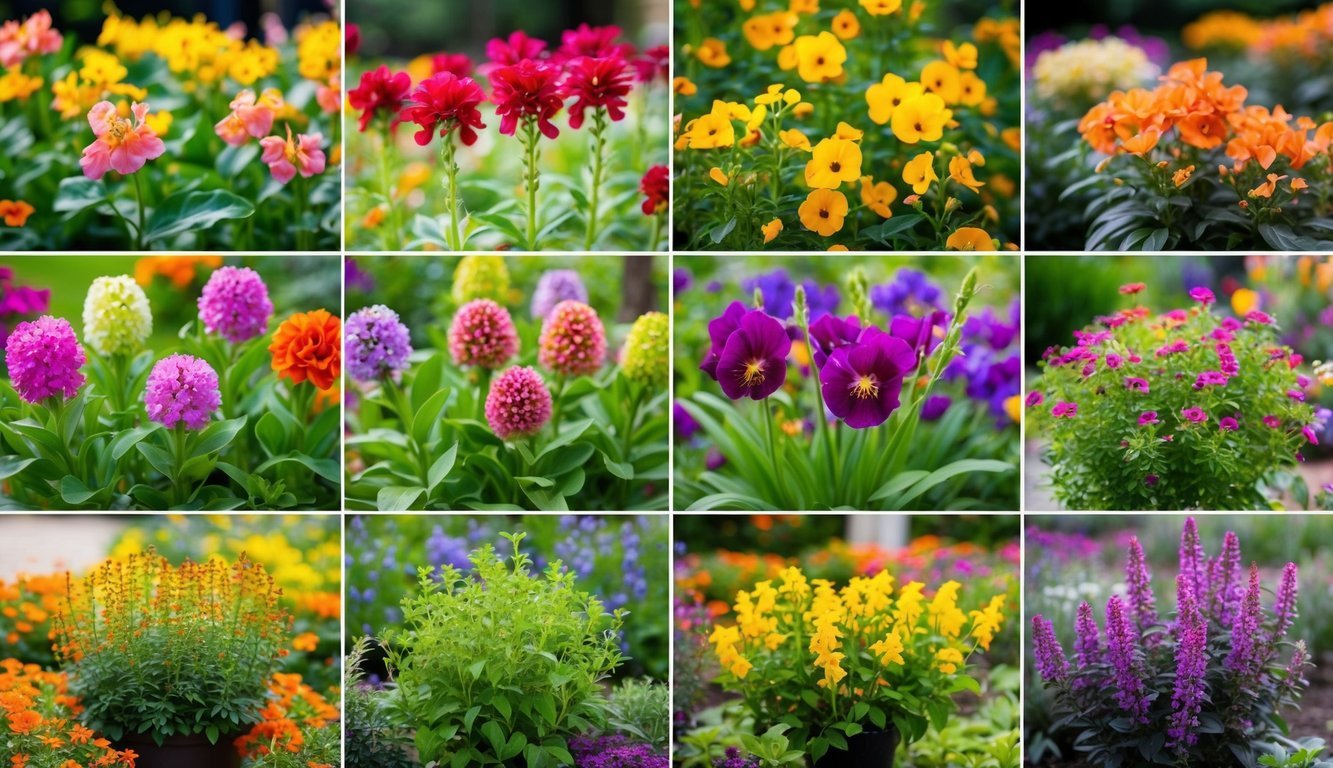
Plant color cycles vary throughout the seasons and between plant types.
By recognizing these cycles, I can choose plants that provide continuous color for my garden.
Seasonal Color Changes
Spring kicks off the color cycle with vibrant blooms from bulbs like tulips and daffodils.
I love how the garden transitions from the fresh greens of new leaves to bright flower displays.
As summer rolls in, my perennials take over.
Plants such as coneflowers and daylilies flourish, adding a riot of color.
In fall, I enjoy the warm hues of chrysanthemums and asters.
During winter, many plants become dormant, but the structural elements of evergreen shrubs and winterberries can still provide visual interest.
It’s fascinating to learn how leaf color changes from green to vibrant reds and yellows during autumn as plants prepare for the cold months.
Perennial Versus Annual Blooms
Understanding the difference between perennials and annuals helps me keep my garden lively.
Perennials return year after year, offering stability in color.
They often bloom later in spring and can extend their display into fall.
Annuals, on the other hand, are short-lived but provide bursts of color.
I can plant them in spring, and they’ll bloom until the first frost.
To make the most of my garden, I plant a mix of both.
This balance ensures that even as one group fades, the other takes center stage, keeping my garden colorful throughout the year.
Selecting the right combinations makes my garden a year-round delight.
Choosing the Right Plants for Your Area
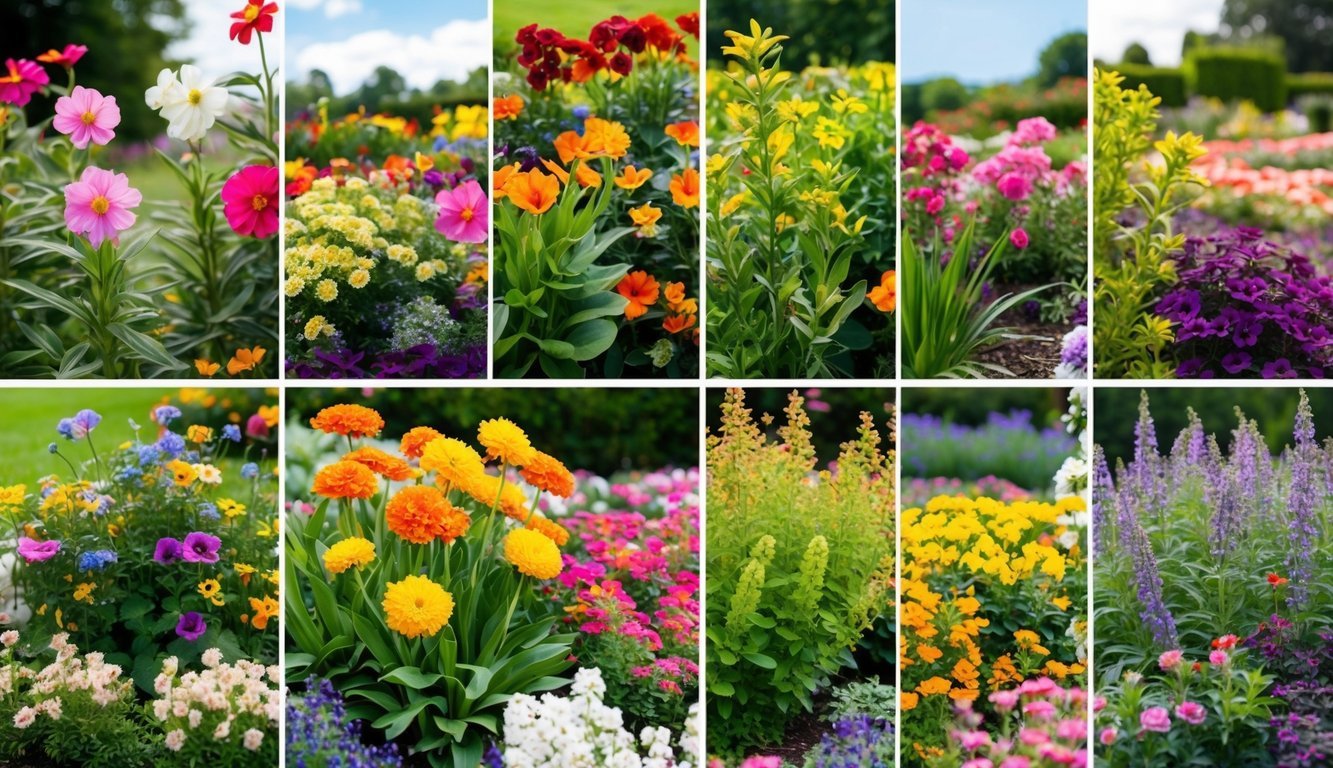
Selecting plants suited to your local climate and soil condition is crucial.
This ensures not only their survival but also vibrant blooms throughout the seasons.
By understanding these factors, I can create a flourishing garden that adds color year-round.
Climate-Specific Selections
Knowing my local climate zone helps me pick the right plants.
For instance, if I’m in a colder zone, I might choose perennials like heuchera or brunnera, which thrive in cooler temperatures.
In warmer zones, I can go for heat-resistant options like salvia or zinnias.
Here’s a quick reference:
| Climate Zone | Recommended Plants |
|---|---|
| 3-4 | Heuchera, Brunnera |
| 5-6 | Daylilies, Coneflowers |
| 7-8 | Salvia, Zinnias |
| 9-10 | Hibiscus, Plumbago |
Choosing plants that flourish in my specific climate guarantees vibrant growth and better chances for survival through the year’s changing seasons.
Soil Compatibility
When selecting plants, I need to consider soil type.
Different plants have varying preferences for soil pH, drainage, and nutrient content.
For instance, if my soil is sandy, I should think about drought-tolerant plants like lavender or sedums, which can thrive in well-drained conditions.
On the other hand, if I have clay soil, I should select moisture-loving plants such as irises or swamp milkweed.
To help me out, here’s a brief checklist:
- Well-Drained Soil: Grow lavender, sedums
- Clay Soil: Opt for irises, swamp milkweed

